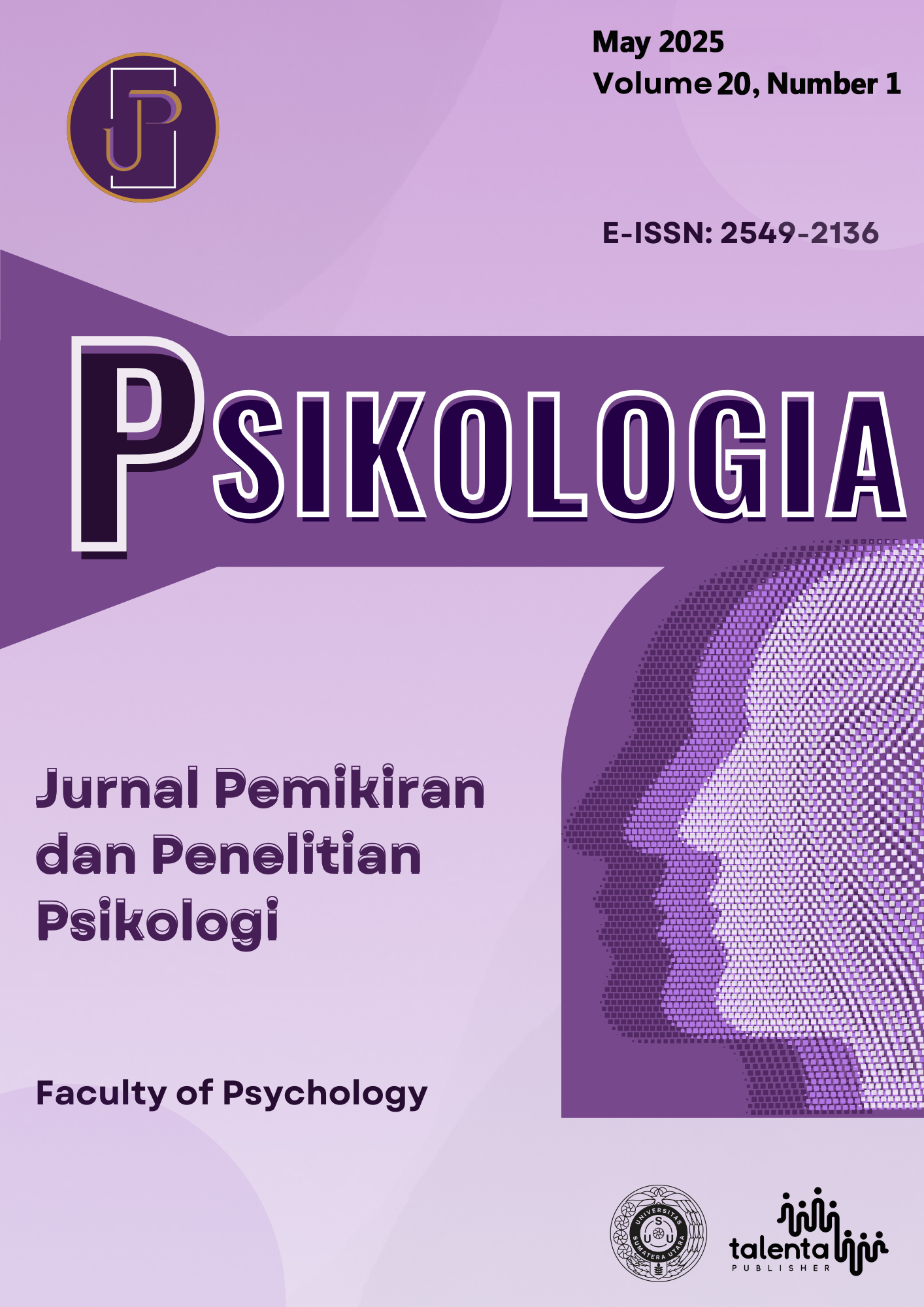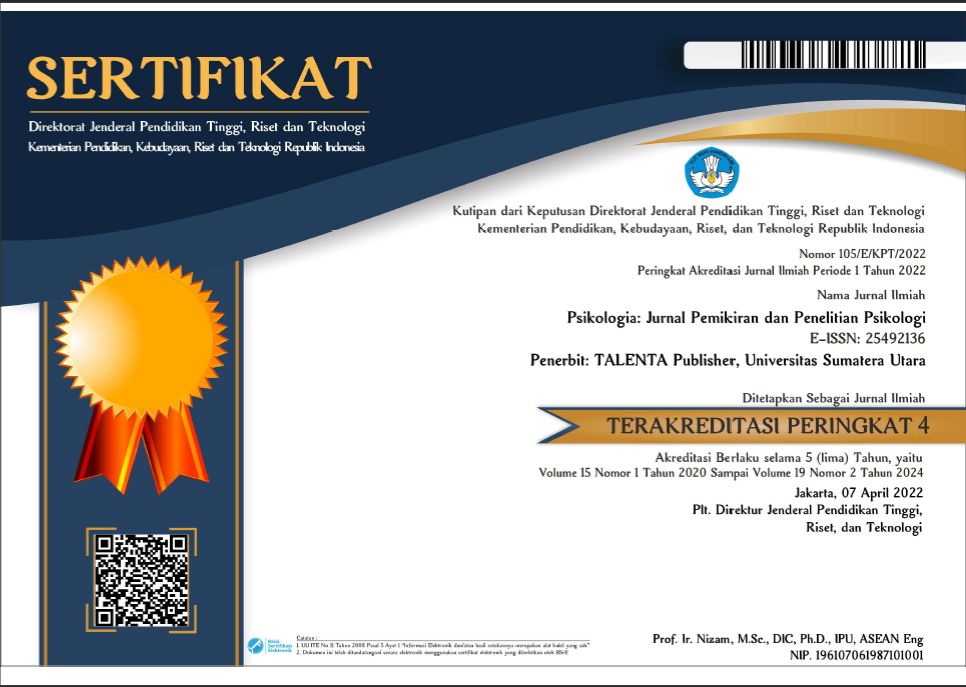Peer attachment with emotion regulation: The influence of affective and cognitive empathy as moderators
DOI:
https://doi.org/10.32734/psikologia.v20i1.19972Keywords:
empathy, peer attachment, emotional regulation, adolescentAbstract
This research examines the role of affective and cognitive empathy as moderators in the relationship between peer attachment and cognitive reappraisal and expressive suppression of emotion regulation in adolescents. The research used a quantitative survey design with 96 junior high school students as participants. Peer attachment was measured using the peer attachment subscale of the Inventory of Parent and Peer Attachment (IPPA), affective and cognitive empathy were measured using the affective and cognitive empathy subscales of the Adolescent Measure of Empathy and Sympathy (AMES), and cognitive reappraisal and expressive suppression of emotion regulation were measured using the Emotion Regulation Questionnaire for Children and Adolescents (ERQ-CA). The results showed a positive relationship between peer attachment and cognitive reappraisal, affective and cognitive empathy with cognitive appraisal. The study also found that affective empathy can mediate the relationship between peer attachment and cognitive reappraisal. This suggests that adolescents' stronger peer attachment and higher levels of affective empathy are associated with a better ability to use cognitive reappraisal to regulate their negative emotions. However, no significant relationships were found between peer attachment, affective empathy, and cognitive empathy with expressive suppression. This may be because other factors influence expressive suppression. These findings highlight the importance of understanding the role of empathy in helping adolescents manage negative emotions through cognitive reappraisal. The implications of this study can support the development of more effective interventions to help adolescents better manage their emotions.
Downloads
References
Armsden, G. C., & Greenberg, M. T. (1987). The inventory of parent and peer attachment: Individual differences and their relationship to psychological well-being in adolescence. Journal of Youth and Adolescence, 16(5), 427–454. https://doi.org/10.1007/BF02202939
Berndt, T. J. (2002). Friendship Quality and Social Development. Current Directions in Psychological Science, 11(1), 7–10. https://doi.org/10.1111/1467-8721.00157
Blair, R. J. R. (2005). Responding to the emotions of others: Dissociating forms of empathy through the study of typical and psychiatric populations. Consciousness and Cognition, 14(4), 698–718. https://doi.org/10.1016/j.concog.2005.06.004
Blair, B. L., Gangle, M. R., Perry, N. B., O’Brien, M., Calkins, S. D., Keane, S. P., & Shanahan, L. (2018). Indirect Effects of Emotion Regulation on Peer Acceptance and Rejection:The Roles of Positive and Negative Social Behaviors. Merril Palmer Q, 62(4), 415–439.
Boele, S., Van der Graaff, J., de Wied, M., Van der Valk, I. E., Crocetti, E., & Branje, S. (2019). Linking Parent–Child and Peer Relationship Quality to Empathy in Adolescence: A Multilevel Meta-Analysis. Journal of Youth and Adolescence, 48(6), 1033–1055. https://doi.org/10.1007/s10964-019-00993-5
Bowlby, J. (1982). Attachment and Loss. Basic Books .
Brieant, A., Holmes, C. J., Maciejewski, D., Lee, J., Deater-Deckard, K., King-Casas, B., & Kim-Spoon, J. (2018). Positive and Negative Affect and Adolescent Adjustment: Moderation Effects of Prefrontal Functioning. Journal of Research on Adolescence, 28(1), 40–55. https://doi.org/10.1111/jora.12339
Calkins, S. D., & Hill, A. (2007). Caregiving influences on emerging emotion regulation: Biological and environmental transactions in early development. In Handbook of emotion regulation. Guilford Press.
Cambron, M. J., Acitelli, L. K., & Steinberg, L. (2010). When Friends Make You Blue: The Role of Friendship Contingent Self-Esteem in Predicting Self-Esteem and Depressive Symptoms. Personality and Social Psychology Bulletin, 36(3), 384–397. https://doi.org/10.1177/0146167209351593
Castellano, E., Muñoz-Navarro, R., Toledo, M. S., Spontón, C., & Medrano, L. A. (2019). Cognitive processes of emotional regulation, burnout and work engagement. Psicothema, 31(1), 73–80.
Collibee, C., LeTard, A. J., & Wargo Aikins, J. (2016). The Moderating Role of Friendship Quality on Associations Between Autonomy and Adolescent Adjustment. The Journal of Early Adolescence, 36(2), 251–266. https://doi.org/10.1177/0272431614562837
Cuff, B. M. P., Brown, S. J., Taylor, L., & Howat, D. J. (2016). Empathy: A review of the concept. Emotion Review, 8(2), 144–153. https://doi.org/10.1177/1754073914558466
Cui, L., Morris, A. S., Criss, M. M., Houltberg, B. J., & Silk, J. S. (2014). Parental Psychological Control and Adolescent Adjustment: The Role of Adolescent Emotion Regulation. Parenting, 14(1), 47–67. https://doi.org/10.1080/15295192.2014.880018
Davis, M. H. (1983). Measuring individual differences in empathy: Evidence for a multidimensional approach. Journal of Personality and Social Psychology, 44(1), 113–126. https://doi.org/10.1037/0022-3514.44.1.113
Demir, M., & Özdemir, M. (2010). Friendship, Need Satisfaction and Happiness. Journal of Happiness Studies, 11(2), 243–259. https://doi.org/10.1007/s10902-009-9138-5
Estevez, A., Jauregui, P., Momeñe, J., & Lopez-Gonzalez, H. (2023). Relationship of gambling disorder with traumatic life events and emotion regulation in adolescents and young adults. Journal of Behavioral Addictions, 12(2), 500–509. https://doi.org/10.1556/2006.2023.00016
French, D. C., Niu, L., & Purwono, U. (2016). Popularity of Indonesian Adolescents: Do the Findings from the USA Generalize to a Muslim Majority Developing Country? Social Development, 25(2), 405–421. https://doi.org/10.1111/sode.12148
Graaff, V. der J., Meeus, W., de Wied, M., van Boxtel, A., van Lier, P. A. C., Koot, H. M., & Branje, S. (2016). Motor, affective and cognitive empathy in adolescence: Interrelations between facial electromyography and self-reported trait and state measures. Cognition and Emotion, 30(4), 745–761. https://doi.org/10.1080/02699931.2015.1027665
Greenaway, K. H., Kalokerinos, E. K., Hinton, S., & Hawkins, G. E. (2021). Emotion experience and expression goals shape emotion regulation strategy choice. Emotion, 21(7), 1452–1469. https://doi.org/10.1037/emo0001012
Gross, J. J., & John, O. P. (2003). Individual differences in two emotion regulation processes: Implications for affect, relationships, and well-being. Journal of Personality and Social Psychology, 85(2), 348–362. https://doi.org/10.1037/0022-3514.85.2.348
Gross, J. J., & Thompson, R. A. (2007). Emotion regulation: Conceptual foundations. In Handbook of emotion regulation . Guilford Press.
Gullone, E., & Taffe, J. (2012). The Emotion Regulation Questionnaire for Children and Adolescents (ERQ–CA): A psychometric evaluation. Psychological Assessment, 24(2), 409–417. https://doi.org/10.1037/a0025777
Hahn, A. M., Simons, R. M., Simons, J. S., & Welker, L. E. (2019). Prediction of verbal and physical aggression among young adults: A path analysis of alexithymia, impulsivity, and aggression. Psychiatry Research, 273, 653–656. https://doi.org/10.1016/j.psychres.2019.01.099
Holley, S. R., Ewing, S. T., Stiver, J. T., & Bloch, L. (2017). The Relationship Between Emotion Regulation, Executive Functioning, and Aggressive Behaviors. Journal of Interpersonal Violence, 32(11), 1692–1707. https://doi.org/10.1177/0886260515592619
Lazarus, P. J., & Costa, A. (2021). Teaching emotional self-regulation to children and adolescents. In Fostering the emotional well-being of our youth: A school-based approach . Oxford University Press.
Lestari, D. A., & Satwika, Y. W. (2018). Hubungan Antara Peer Attachment dengan Regulasi Emosi pada Siswa Kelas VIII di SMPN 28 Surabaya. Character: Jurnal Penelitian Psikologi, 5(2), 1–6.
Lissa, van C. J., Hawk, S. T., de Wied, M., Koot, H. M., van Lier, P., & Meeus, W. (2014). The longitudinal interplay of affective and cognitive empathy within and between adolescents and mothers. Developmental Psychology, 50(4), 1219–1225. https://doi.org/10.1037/a0035050
Lopez, R. B., Brown, R. L., Wu, E.-L. L., Murdock, K. W., Denny, B. T., Heijnen, C., & Fagundes, C. (2020). Emotion Regulation and Immune Functioning During Grief: Testing the Role of Expressive Suppression and Cognitive Reappraisal in Inflammation Among Recently Bereaved Spouses. Psychosomatic Medicine, 82(1), 2–9. https://doi.org/10.1097/PSY.0000000000000755
Luthfi, I. M., & Husni, D. (2020). Peer Attachment dengan Regulasi Emosi Pada Santri. Psikobuletin:Buletin Ilmiah Psikologi, 1(2), 110. https://doi.org/10.24014/pib.v1i2.9374
Maibom, H. L. (2019). Empathy and Emotion Regulation. Philosophical Topics, 47(2), 149–164.
Narr, R. K., Allen, J. P., Tan, J. S., & Loeb, E. L. (2019). Close Friendship Strength and Broader Peer Group Desirability as Differential Predictors of Adult Mental Health. Child Development, 90(1), 298–313. https://doi.org/10.1111/cdev.12905
Nicolaisen, M., & Thorsen, K. (2017). What Are Friends for? Friendships and Loneliness Over the Lifespan—From 18 to 79 Years. The International Journal of Aging and Human Development, 84(2), 126–158. https://doi.org/10.1177/0091415016655166
Nyquist, A. C., & Luebbe, A. M. (2022). Parents’ Beliefs, Depressive Symptoms, and Emotion Regulation Uniquely Relate to Parental Responses to Adolescent Positive Affect. Family Process, 61(1), 407–421. https://doi.org/10.1111/famp.12657
Pace, U., Zappulla, C., & Di Maggio, R. (2016). The mediating role of perceived peer support in the relation between quality of attachment and internalizing problems in adolescence: a longitudinal perspective. Attachment & Human Development, 18(5), 508–524. https://doi.org/10.1080/14616734.2016.1198919
Panfile, T. M., & Laible, D. J. (2012). Attachment Security and Child’s Empathy: The Mediating Role of Emotion Regulation. Merrill-Palmer Quarterly, 58(1), 1–21. https://doi.org/10.1353/mpq.2012.0003
Pascuzzo, K., Cyr, C., & Moss, E. (2013). Longitudinal association between adolescent attachment, adult romantic attachment, and emotion regulation strategies. Attachment & Human Development, 15(1), 83–103. https://doi.org/10.1080/14616734.2013.745713
Pinheiro Mota, C., & Matos, P. M. (2013). Peer attachment, coping, and self-esteem in institutionalized adolescents: the mediating role of social skills. European Journal of Psychology of Education, 28(1), 87–100. https://doi.org/10.1007/s10212-012-0103-z
Powell, P. A. (2018). Individual differences in emotion regulation moderate the associations between empathy and affective distress. Motivation and Emotion, 42(4), 602–613. https://doi.org/10.1007/s11031-018-9684-4
Putriningsih, A., & Kusumaningrum, F. A. (2022). Peer Attachment and Emotion Regulation in Adolescents. Proceedings of 3rd International Conference on Psychological Studies (ICPsyche), 13–22. https://proceeding.internationaljournallabs.com/index.php/picis/index
Rasyid, M., & Suminar, D. R. (2012). Hubungan antara Peer Attachment dengan Regulasi Emosi Remaja yang Menjadi Siswa di Boarding School SMA Negeri 10 Samarinda. Jurnal Psikologi Pendidikan Dan Perkembangan, 1(3), 1–7.
Rizaty, M. A. (2022). Tawuran Pelajar Paling Banyak Terjadi di Jawa Barat. Databoks.
Roeser, R. W., Eccles, J. S., & Sameroff, A. J. (2000). School as a Context of Early Adolescents’ Academic and Social-Emotional Development: A Summary of Research Findings. The Elementary School Journal, 100(5), 443–471. https://doi.org/10.1086/499650
Saepudin, M. (2019). Pengaruh empati, regulasi emosi dan anonimitas terhadap civility di media sosial. UIN Syarif Hidayatullah.
Santrock, J. W. (2012). A topical approach to life-span development (6th ed.). McGraw-Hill.
Schipper, M., & Petermann, F. (2013). Relating empathy and emotion regulation: Do deficits in empathy trigger emotion dysregulation? Social Neuroscience, 8(1), 101–107. https://doi.org/10.1080/17470919.2012.761650
Schoeps, K., Mónaco, E., Cotolí, A., & Montoya-Castilla, I. (2020). The impact of peer attachment on prosocial behavior, emotional difficulties and conduct problems in adolescence: The mediating role of empathy. PLOS ONE, 15(1), e0227627. https://doi.org/10.1371/journal.pone.0227627
Schwartz-Mette, R. A., Shankman, J., Dueweke, A. R., Borowski, S., & Rose, A. J. (2020). Relations of friendship experiences with depressive symptoms and loneliness in childhood and adolescence: A meta-analytic review. Psychological Bulletin, 146(8), 664–700. https://doi.org/10.1037/bul0000239
Soekoto, Z. A., Muttaqin, D., & Tondok, M. S. (2020). Kualitas pertemanan dan agresi relasional pada remaja di kota Surabaya. Jurnal Psikologi, 6(2), 188–201.
Stotland, E. (1969). Exploratory Investigations of Empathy. Advances in Experimental Social Psychology, 4(C), 271–314. https://doi.org/10.1016/S0065-2601(08)60080-5
Syukriani, Y., Noviandhari, A., Arisanti, N., Setiawati, E. P., Rusmil, V. K., Dhamayanti, M., & Sekarwana, N. (2022). Cross-sectional survey of underreported violence experienced by adolescents: a study from Indonesia. BMC Public Health, 22(1), 50. https://doi.org/10.1186/s12889-021-12427-8
Thompson, N. M., Uusberg, A., Gross, J. J., & Chakrabarti, B. (2019). Empathy and emotion regulation: An integrative account (pp. 273–304). https://doi.org/10.1016/bs.pbr.2019.03.024
Thompson, R. A. (1994). Emotion Regulation: A Theme in Search of Definition. Monographs of the Society for Research in Child Development, 59(2/3), 25. https://doi.org/10.2307/1166137
Verhees, M. W. F. T., Finet, C., Vandesande, S., Bastin, M., Bijttebier, P., Bodner, N., Van Aswegen, T., Van de Walle, M., & Bosmans, G. (2021). Attachment and the Development of Depressive Symptoms in Adolescence: The Role of Regulating Positive and Negative Affect. Journal of Youth and Adolescence, 50(8), 1649–1662. https://doi.org/10.1007/s10964-021-01426-y
Vossen, H. G. M., Piotrowski, J. T., & Valkenburg, P. M. (2015). Development of the Adolescent Measure of Empathy and Sympathy (AMES). Personality and Individual Differences, 74, 66–71. https://doi.org/10.1016/j.paid.2014.09.040
Wante, L., Van Beveren, M.-L., Theuwis, L., & Braet, C. (2018). The effects of emotion regulation strategies on positive and negative affect in early adolescents. Cognition and Emotion, 32(5), 988–1002. https://doi.org/10.1080/02699931.2017.1374242
Weiss, R. S. (1982). Attachment in adult life. In The Place of Attachment in Human Behavior. Basic Books.
Wulandari, P. Y. (2019). Model Empati Anak Usia Dini: Peran Strategi Konflik Saudara Kandung Dengan Mediasi Theory of Mind (Tom) Dan Regulasi Emosi. October 2019. http://repository.unair.ac.id/id/eprint/92195
Yana. (2022). Catatan KPAI 2022: Pengeroyokan dan Tawuran Pelajar Marak Terjadi. Channel 9.
Yuan, J., Ju, E., Meng, X., Chen, X., Zhu, S., Yang, J., & Li, H. (2015). Enhanced brain susceptibility to negative stimuli in adolescents: ERP evidences. Frontiers in Behavioral Neuroscience, 9. https://doi.org/10.3389/fnbeh.2015.00098
Yuliana, Y., & Muslikah, M. (2021). Hubungan antara Empati dan Konformitas Teman Sebaya dengan Perundungan Verbal Siswa. ENLIGHTEN (Jurnal Bimbingan Dan Konseling Islam), 4(1), 14–19. https://doi.org/10.32505/enlighten.v4i1.2150
Zahro, I. F. (2017). Pengaruh Pelatihan Empati Melalui Kartu Ekspresi Emosi Terhadap Perilaku Menolong Dan Perilaku Agresif Pada Anak Prasekolah. JCE (Journal of Childhood Education), 1(1), 1–13. https://doi.org/10.30736/jce.v1i1.1
Downloads
Published
How to Cite
Issue
Section
License
Copyright (c) 2025 Bening Siti Muntamah and Muhammad Fikri Pratama

This work is licensed under a Creative Commons Attribution-ShareAlike 4.0 International License.









